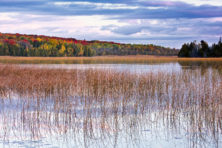Wild Things: Blaze Orange to Color the Woodlands
- Share
- Tweet
- Pin
- Share

Wisconsin’s most anticipated opening morning – the November gun deer season – is just eight toss-and-turn nights away.
While a far cry from its glory days of the 1990s when it attracted nearly 700,000 license-buying men, women and youths, the nine-day hunt is still the granddaddy of all, luring more than 550,000 people to dress in the required blaze orange (blaze pink is also legal, though far less popular).
It’ll be followed by a 10-day muzzleloader deer season Nov. 27-Dec. 6, and a four day, antlerless-only gun deer hunt Dec. 7-10.
More than 70,000 whitetails have already been taken statewide this season, including nearly 23,000 in seven days between Halloween and Nov. 6 alone.
Door and Kewaunee County hunters were closing in on 1,400 deer registered; Door 769 (372 antlered bucks), and Kewaunee 625 (330 bucks).
Last week’s success stories included 278 bucks and 120 antlerless deer reported by Door and Kewaunee County archers and crossbow users, by far the largest weekly harvest of the season. That correlates with not only an increase in deer activity due to the annual mating season, but more hunters spending more time afield.
Statewide, crossbow enthusiasts had 37,027 registrations, including 22,597 bucks. That compares to 25,143 deer for archery hunters (14,790 bucks) and 7,857 whitetails taken during the youth gun deer hunt (3,950 bucks).
Even with all those deer harvested, motorists should remain on high alert as the breeding season is at its peak.
This is the final weekend to sight in your favorite firearm and check stands or blinds for needed adjustments or repairs. And even though it’s not required – except on state wildlife areas and on some other properties open to the public – it’s wise to put some blaze orange material on ground blinds.
It’s also a good idea to get together with your gun deer-hunting partners to discuss pre-season plans, and in-season safety. Be sure everyone knows where and when they can and cannot shoot, and get on the same page if setting up some planned pushes after opening weekend.
While the farmland harvest has been strong this fall, the kill in northern Wisconsin was running about 30 percent behind after a very snowy winter and – at least according to many of those who hunt there – too many wolves eating deer year-round, and black bears preying on fawns.
Farmland hunters are watching the harvest closely. This week’s ag report noted that only about one-third of corn for grain had been cut in northeast Wisconsin. Also running behind was the soybean harvest (about two-thirds complete). Meanwhile, winter wheat planting (96 percent) and emergence (87 percent) was ahead of the five-year average.
For more on the gun deer hunt, visit dnr.wisconsin.gov/topic/hunt/deer.
Donate a Deer
Marchant’s Venison Processing and Haberli’s Deer Processing are participating in this year’s Deer Donation Program coordinated by the Department of Natural Resources (DNR).
Marchant’s is located at 9420 Cemetery Road in Brussels (920.495.7013), while Haberli’s is at 4259 Haberli Road, Sturgeon Bay (920.743.5736).
Another option for those closer to Green Bay is to contact Paul’s Pantry, 920.433.0343, and make an appointment to drop off the deer.
Since the program began 23 years ago, state hunters have donated nearly 100,000 deer totaling almost 4 million pounds of ground venison to help those in need.
Food pantries and other partners distribute the meat, which is packaged as hamburger.
With more than 900,000 state residents receiving food assistance, DNR program administrator Grace Nugent said it’s a great opportunity for hunters to showcase their sportsmanship and help individuals facing food insecurity.
Deer must be field-dressed and registered (bring the confirmation number) before dropping off at the processor. You must donate the entire carcass, though you can make arrangements to keep the head, cape and antlers.
Anyone can support the program by donating a dollar or more at hunting license sales locations or online via the DNR’s Go Wild website.
Salmon Run Update
At the DNR’s Besadny Anadromous Fisheries Facility on the Kewaunee River, 713 Chinooks and 300 cohos were sorted between Oct. 7-Nov. 1, and nearly a half-million coho eggs were taken.
Meanwhile, between Sept. 25 and Nov. 6, 2,397 Chinooks and 1,786 cohos were handled at the Root River facility in Racine. There were 424 cohos spawned.
Just under 4,000 Chinook salmon were seen at the Strawberry Creek facility in October. An estimated 3.4 million eggs were taken from 650 females.
Weekly Water Levels
Green Bay and Lake Michigan water levels have dropped two inches in the past month, but are only an inch below last November’s levels. As of Nov. 3, levels were 33 inches lower than the monthly record high, set in 1986, and 35 inches above the record low, set in 1964. The seasonal decline continues, with a drop of another three inches predicted by early December.

